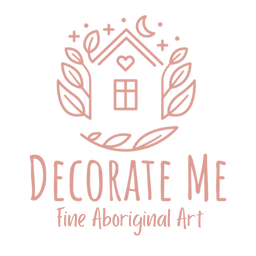Aboriginal Art and Aboriginal Dreamtime
Australian aboriginal art is unique and often based on stories and symbols that focus on aboriginal dream time, which is when aboriginal people believe the world was created.
Some of the designs and stories have been passed down for the past 65,000+ years through dream time storytelling and the aboriginal art that keeps everything alive.
So when you have or see aboriginal art, it’s based on stories or designs from up to 65,000+ years ago, which is something incredible to think about. Many of the western artists we consider to be the greats were painting within the last 400, and some of the stories they might have painted happened within the past 2000-4000 years.
If you’re curious about aboriginal art, listed below are ten facts to keep your interest and encourage you to look further into this unique art style.
Unique And Interesting Facts About Aboriginal Art
Aboriginal Art is Based on Dreamtime
Dreamtime is the basis of Aboriginal culture and religion; it dates back 65,000+ years ago and for the Aboriginal people it tells of how the universe was created, events that have happened, how humans were created, and how the creator intended humans to function in the world.
Aboriginal art has been used for thousands of years and draws on the symbols, ideas, and stories from Dreamtime; it’s a way to pass historical information down the line, and it continues to be the case now.
Aboriginal Art Is Used Instead of Historical Writing
Australian Aboriginal people have no written language, and the only record-keeping has been aboriginal art. The way that information has been passed down through the generations has been through artwork.
As time has gone on, many important events and cultural information have been incorporated into aboriginal art and passed down to each generation to use and keep the culture alive.
Teaching Younger Generations Happens Through Aboriginal Art
Aboriginal art is a way to teach and show symbols or relay stories from the past. The way the story is told can convey different meanings to different groups, so Aboriginal art being explained to younger generations can have a slightly different meaning than for the older generations.
Either way, Aboriginal art is a way to educate everybody on historical events and cultural and religious ideas that have been used for thousands of years. It’s the primary method of education for entire tribes and outsiders.
There Are Many Aboriginal Groups With Different Stories
Australia is very big, and Aboriginal tribes were spread throughout the entire country. While many of the ideas are similar, each tribe or group has slight differences in interpretations and even ways of representing ideas.
So the Aboriginal art coming from different regions can be completely different in style and design, and it offers many unique perspectives for people to experience.
You Need Permission To Paint Dreamtime Stories
Aboriginal artists can paint whatever they want; however, if they want to incorporate Dreamtime stories into their art, they must have permission to do so. Any traditional aboriginal artist can only paint Dreamtime stories that have been passed down through the generations of their family and their country.
So just knowing about a Dreamtime story or educating yourself about the stories may not be enough to be allowed to create art around that story officially.
Aboriginal Art Is Considered New
While Aboriginal art has been drawn on cave walls or has been used in stories ad-hoc when people are telling them, there is no real historical use of paintings in Aboriginal culture. It wasn’t until around 1971 that Aboriginal people were encouraged to start putting their Dreamtime art onto canvas.
So the majority of Aboriginal art on canvas wasn’t created until the ’70s until right up to now, with a sizeable Aboriginal art movement happening in Australia.
Secrets Can Be Hidden In Aboriginal Art
By using sacred and secret symbols in Aboriginal art, some Aboriginal people became concerned that outsiders would start learning the secrets within the Dreamtime artwork that was being created.
So a method of overlaying dots on the symbols and designs was incorporated into many pieces of Aboriginal art. However, this hiding of information has turned into a style of its own called “Dot Painting” or “Over Painting.”
Aboriginal Art Is Often Shown In Museums
You’re just as likely to see Aboriginal art in museums as you are to see it in art galleries. Australian aboriginal culture is the longest-lasting culture the world has ever known about.
Aboriginal art is heavily focused on Dreamtime teachings, spiritual information, knowledge passed down through 65,000+ years’ worth of generations and provides an insight into the cultural behaviour of Aboriginal peoples.
Aboriginal art has both a place in the art world and has enormous anthropological merits that museums want to include and keep safe. Because much of the historical art from Aboriginal peoples was never painted on canvas, the newer artworks are often included in museums for the significance behind the symbolism.
High Prices Can be Paid For Aboriginal Art
Aboriginal Art still fetching high prices worldwide for single pieces.
The most expensive piece of Aboriginal art sold to date was in 2007 for 2.4 million dollars. It was created by Clifford Possum Tjapaltjarri and sold to the National Gallery of Australia. It was originally created in 1977 and sold to the Commonwealth Bank for $1,200.
Another Aboriginal painting, ‘Water Dreaming’ by Johnny Warangkula Tjupurrula, was sold in 1973 for only $150. However, in 2000 the artwork was sold for $486,500.
In 2017, ‘Earth’s Creation’ by Emily Kame Kngwarreye was sold for $2.1 million, which is the highest price paid for Aboriginal art by an Aboriginal woman and the highest price for any woman in Australia.
Aboriginal Art Keeps Aboriginal Culture Strong
With the emergence of Aboriginal art in the 1970s and going strong today, it’s seen an emergence in interest from younger aboriginal people that are looking to reconnect with their roots or understand more about their culture, history, and religious beliefs of their people.
It’s also a great way to showcase more about Australian Aboriginal people and the culture they’ve been fostering for thousands of years to a world that may not even be able to fathom that length of time.


